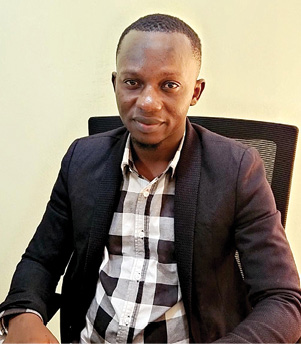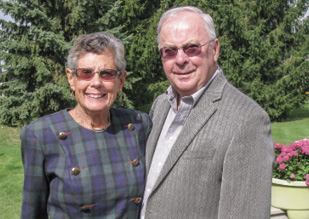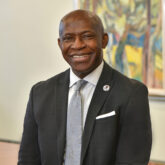But while the senior researchers were concentrating on those clusters, Sherman noticed there were differences in the right hemisphere as well.
That meant dyslexia affected the brain in regions outside of language development. Some of these differences resulted in stronger than average development of portions of the brain responsible for visual and spatial skills.
His 20 years of research at the Dyslexia Laboratory at Beth Israel Deaconess Medical Center/Harvard Medical School eventually led to the development of a concept he calls “cerebrodiversity.” The term, which he coined, refers to humanity’s collective neural heterogeneity and places brain variation in an evolutionary context.
Cerebrodiversity asserts that brains are unique (much like our fingerprints, he says) and process information differently from each other, and those differences within a brain can simultaneously present advantages and disadvantages for an individual.
Many people with dyslexia have found great success in many areas—particularly subjects or activities that benefit from a “big picture” perspective or “out-of-the-box” thinking, including as inventors, musicians, artists, entrepreneurs, baseball outfielders and even writers and poets. Among those reported to be dyslexic are Thomas Edison, Alexander Graham Bell, Leonardo DaVinci, Pablo Picasso, Andy Warhol, Erin Brockovich, Nelson Rockefeller, Agatha Christie, Charles Schwab and Steven Spielberg, among many others.
Sherman believes the diversity in our brains creates an adaptive advantage for humans as a species and allows us to leverage individuals’ strengths for collective success.
For example, Sherman points out that dyslexia as a disability didn’t exist until after the advent of the printing press, but it is very likely that there were people with brains that had the same clusters of neurons in their cerebral cortex.
Likewise, the pervasiveness of technology in our society might lead to the discovery of “dystechnia” in people whose brains are unable to adapt quickly to technological changes, he half-joked.
 “I thought I would be a researcher forever,” Sherman said. “But then I was challenged to think about what could be done for people with dyslexia. What could I do to be more hands on and help people?”
“I thought I would be a researcher forever,” Sherman said. “But then I was challenged to think about what could be done for people with dyslexia. What could I do to be more hands on and help people?”
When the founders of the Newgrange School in Hamilton, N.J., approached Sherman in 2000 to become head of the school, he remembers balking.
“It sounded ridiculous,” he said. “I knew a lot about dyslexia, but what did I know about schools? Then I realized I could help bridge the chasm between research and education. It would be a great challenge, and I was ready to take it on.”
After all, this wasn’t the first time that Sherman’s life course took an unexpected turn.
As the only son of a World War II and Korean War veteran and a mother who worked in retail, Sherman was expected to work in a Rome, N.Y., factory alongside his father.
“I worked on the dangerous assembly line at the Revere Copper and Brass factory, clipping off the sharp edges of big Dutch Oven pans,” he said. “It was the worst summer of my life. Then out of the blue, an aunt of mine said she heard that there were openings for the incoming freshman class at Oswego State and maybe we should check it out.”
He was accepted into the freshman class and hoped this would be the first step toward helping him figure out what he wanted to do with his life.
“I entered Funnelle Hall, and my life changed very quickly in a positive way,” said Sherman, who was the first in his family to attend college. He said he wanted to get the most out of his Oswego experience, including “trying out all the grades.”
“The first semester I got all the grades—A, B, C and D,” he said. While he still contends the D in his German class was unfair, the A he earned in his psychology class that first semester launched what would become a very successful career in neuroscience research.
“I had been waiting for a class like psychology—where I began to understand a lot of the issues we all have and why we think like we do or how the brain works,” he said. Much of his time at Oswego, including summers and breaks, he spent in the psychology labs in the basement of Mahar Hall—or with his future wife, the late Nancee Griffiths Sherman ’74.
The couple married in August 1975 and moved to Connecticut, where Gordon enrolled in the Ph.D. program in developmental psychobiology at the University of Connecticut. After graduation, they moved to Boston for Gordon’s job at the Dyslexia Laboratory.
But after 20 years, research in his field was shifting toward neurobiology and mapping of individual neurons, and the Newgrange School had inquired about his interest in being the new executive director.
“I had been doing many presentations on my research, and that work opened my eyes to the possibility of doing something else and having more of a direct impact on children with dyslexia,” Sherman said. “Plus, if I was going to make a change, this would be the time to move my family.”
And after some thought, Sherman, his wife and their two daughters, Laura and Emily, left Boston for Princeton, N.J.
“When I heard he was coming to New Jersey, I felt like we had been given a gift,” said Ann Robinowitz, a learning disability teacher of 35 years who knew Sherman when he was president of the International Dyslexia Association and has now worked with him for the past six years on the Newgrange School Board of Trustees.
“His work was absolutely eye-opening,” she said. “He has helped us provide multisensory education that was an outgrowth of his research. It’s one thing to do the research, but he’s put that into practice. He is so admired by the students and parents.”
Today, Sherman is the executive director of the Newgrange School of Princeton, which includes the Newgrange School in Hamilton, N.J., a publicly and privately funded school for students with a range of learning differences, and its sister school, the Laurel School of Princeton, a private school for students with dyslexia that he founded three years ago.
Although he has written and edited more than 80 scientific articles, reviews and books; was the recipient of the Samuel T. Orton Award; has been the featured speaker at numerous conferences and was inducted into the International Dyslexia Association’s Sylvia O. Richardson Hall of Honor, Sherman said he is most proud of his work with Newgrange and Laurel schools.
“We took a concept and made it a guide in establishing a school for dyslexic children,” he said. “We sought to create a warm and supportive environment that would allow the students to be confident in their ability to learn to read and write well. Providing that environment—seeing how the students react and how their self-esteem remains high when working with a very difficult set of issues—that is what I am most proud of,” he said.
Much as SUNY Oswego founder Edward Austin Sheldon employed “object learning” and the Pestalozzian Method’s belief in the capability of every individual to learn, Sherman, informed by decades of research, is committed to create an educational environment in which diverse learners—with their unique strengths and weaknesses—can thrive.
Sarah Piano, whose 9-year-old son, Andrew, attends the Laurel School, said Sherman’s methods have transformed her son.
Three years ago, Andrew was struggling in school and was starting to fall behind in reading. Today, his mother said her son, who has been diagnosed with multiple learning disabilities, including dyslexia, enjoys reading and loves attending school.
“Dr. Sherman is an outstanding researcher and educator in the field of dyslexia, and he truly cares about his students’ success,” she said. “I am thrilled with the progress my son has made. He has definitely benefited from the individualized programs here at the Laurel School. They have tailored his education to take into account his strengths and weaknesses, and he learned to read using multisensory, structured techniques and using technology like an iPad and a Chromebook.”
Although Sherman earned a degree in psychology, not teaching, at SUNY Oswego, he said a recent trip to campus for his 40th Reunion in June made him remember how much his education shaped his future.
“If I hadn’t come to Oswego, who knows where I would have ended up,” he said.
–Margaret Spillett
Dr. Sherman’s Top 5 Predictions
1. Creative technologies empower all brains to perform at increased levels of proficiency.
2. “Design-thinking curricula” revolutionize teaching and learning, advancing not only creativity and innovation, but also critical thinking, communication and collaboration.
3. The faulty premise behind IQ and the limitations of standardized testing are understood and the dominance of both erodes.
4. Biotech memory enhancers improve learning and lead to breakthroughs in diseases such as Alzheimer’s.
5. We abandon the 19th century model of schooling and adopt a differentiated, technology-based, humane model that prepares children to lead fulfilling, productive and responsible lives in a digital society.
More from Alumni Profiles
Astrophysicist, Yale Professor Credits Oswego with Setting His Course for Stellar Career
Astrophysicist, Yale Professor Credits Oswego with Setting His Course for Stellar Career Earl Bellinger ’12 is one stellar guy. A quick review …
BHI Alumnus from Liberia Gains World of Experience
BHI Alumnus from Liberia Gains World of Experience Otis Gbala M’23 became the first SUNY Oswego graduate who studied from Liberia …
Couple’s Loyal Support for Oswego Spans Five Decades
Couple’s Loyal Support for Oswego Spans Five Decades Marilynn “Lynn” Nagy Farrar ’61 and Neil Farrar cherish their memories of Oswego …












